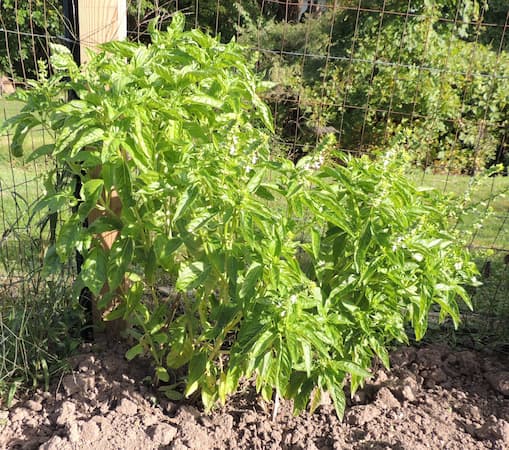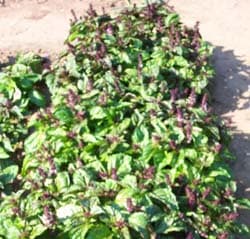How to Grow Basil Herb Plants

How to Grow Basil in Your Herb Garden
Basil herbs are among the most popular plants to grow in the home herb garden. Basil plants are about as easy to grow, as any plant can be. The plant is attractive, with many varieties to choose from. Among them, are varieties stealing a bit of flavor from anise, cinnamon, lemon, and even licorice. There are spicy varieties and sweet ones, too. Take your pick, but make sure to include at least one or two varieties of this popular herb in your garden.
This bushy plant grows 10-12 inches tall, with tooth-edged leaves. The leaves are varying shades of green to dark green, depending upon variety. Fragrant, purplish-white flowers grow on tall spikes. These attractive flowers, popular with bees, are sometimes used in bouquets.
In the kitchen, the many varieties of Basil find their way into a huge number of recipes around the world. None are more popular though than the many Italian recipes.
Basil grows well in herb gardens, flower gardens, containers, and pots. They make a good indoor plant in a sunny window. Try growing them indoors over the winter.
Botanical Name: Annual, Ocimum Basilicum
How to Grow Basil - There's Varieties A'Plenty
There are many varieties, including: Spicy Globe, Cinnamon, Dark Opal, Greek, Genovese (Italian type), Lemon, Lettuce Leaf, Sweet Basil (the most popular), Purple, Siam Queen, and more!
Medicinal Benefits and Applications:
Basil is known for its anti-oxidant properties. It helps to fight off heart disease and cancer. Its antibacterial properties help promote stomach health.

How to Grow Basil - Plant Propagation
Basil is grown from seed. It is popular to start seeds indoors in containers first. Started early and placed in a sunny window, many lucky gardeners will be using the leaves before the outdoor planting season has even begun! Transplant the seedlings outdoors after there are at least 4-six leaves, and after all danger of frost has passed.
Basil seeds can also be directly seeded into your garden, after all danger of frost.
Space seedlings or thin plants to 10″ apart, in rows two feet apart. Some gardeners will grow just a few plants in clumps. They will tolerate a little crowding.
How to Grow Basil Herb Plants

Basil is very easy to grow. They prefer full sun. They do well in average soils and tolerate dry soil conditions.
Water plants during dry periods, at least once a week.
Add a general-purpose fertilizer once or twice a season.
Harvest leaves and stems as soon as there are enough to use in your favorite basil recipe. Rinse well, then dry them in a cool, dry place. Make sure they are completely dried before storing. You can also freeze basil for later use.
As plants get big, pinch the growing tips, for bushier growth.
It is not a hardy plant. Consequentially, they will succumb to the first fall frost.
Basil makes good houseplants. As fall arrives, take young plants and transplant them into a decorative indoor houseplant pot or container. Gradually adjust them to lower and lesser light levels to minimize leaf drop. You can also start new plants indoors from seed.
How to Grow Basil - Culinary Uses
Basil shines in kitchens around the world. From Thailand to the Mediterranean to the United States, there is no shortage of recipes.
Basil is a standard in pizzas, spaghetti sauces, and pestos. It adds flavor to spaghetti sauce, cheeses, soups omelets, and salads. It is also used fresh for sliced tomatoes, as a garnish, or for flavoring meats, and cooked in stir-fries.
Related Articles
Also, people who liked this article, will also like:
Companion Plants – This herb is an excellent companion plant.
Growing Basil in the Herb Garden – by Garden Hobbies
Recipes: May we suggest:
We hope you liked this article on "How to Grow Basil. Please tell your friends about us.
Please support our site. Shop for:
- rmmatthews100@hotmail.com
- 585-721-6528
- Rochester, NY
©1999-2024 GardenersNet.Com, All Rights Reserved

